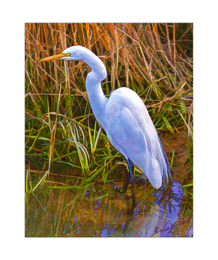Wildlife Tidbits
Identifying Characteristics
— Large white bird
— Long neck and legs
— Flies with it's neck retracted
— Thick and long yellow bill
— Black legs and feet
Habitat Characteristics
— Common in and around wetlands,
rivers, larger creeks and sloughs,
bays, lagoons and marshes
— Typically feeds in shallow water
— Also found feeding in open fields
— Nests in the tops of trees near water
Fun Facts
— The Great Egret has been known by seveal other names, including Common Egret, Great White Heron or
Great White Egret, American Egret and Large Egret.
— These large birds can be up to 3-1/4 feet tall when standing.
— Adult Great Egrets can have a 5-1/2 to 7 foot wingspan.
— Despite their large appearance the average Great Egret tips the scales at only 2-1/4 pounds.
— Favorite foods include frogs, fish, crayfish, snakes, lizards, small mammals and insects.
— Great Egrets use their bills to spear their prey.
— Great Egrets are not noisy birds - you'll likley only hear them when they're disturbed or breeding.
— Frilly ornamental feathers off the back means that it's breeding season.
— Great Egrets nest in groups called colonies. A group of nesting birds is called a breeding colony. Although
there can be a variety of reasons for nesting in a group, most feel it's a means of reducing predation.
— Both the male and female take care of the young after hatching.
— These migratory birds prefer warmer weather and will move during
winter to find it.
— The average Great Egret life span is 15 years.
Taxonomy
— Birds are in the class "Aves"
— The Great Egret is in the heron family "Ardeidae"
— It's genus is "Ardea"
— And the species name is "Ardea alba"

More Information